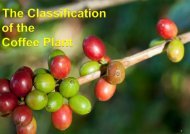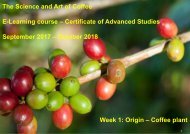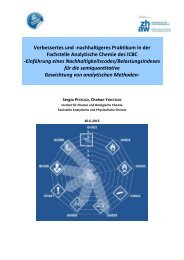You also want an ePaper? Increase the reach of your titles
YUMPU automatically turns print PDFs into web optimized ePapers that Google loves.
In summary only three c<strong>of</strong>fee species are <strong>of</strong> relevance when it comes to international c<strong>of</strong>fee consumption, C<strong>of</strong>fea<br />
canephora Pierre ex Froehner, C. arabica L., C. liberica Bull ex Hiern. The name (or letter) after <strong>the</strong> species<br />
refers to <strong>the</strong> author, who validly published this botanical name. In case <strong>of</strong> Arabica c<strong>of</strong>fee, it was Carl von Linné<br />
(abbreviated L.), who described <strong>the</strong> Typica variety as <strong>the</strong> reference Arabica <strong>plant</strong>, hence <strong>the</strong> name <strong>of</strong> that<br />
variety. The term “ex” means that <strong>the</strong> initial description was not sufficient or that <strong>the</strong> botanical systematic was<br />
changed. For Robusta it means that Pierre was <strong>the</strong> first to describe <strong>the</strong> <strong>plant</strong>, but <strong>the</strong> correct and final description<br />
was done by Froehner.<br />
As already mentioned, fertility among <strong>of</strong>fspring is a characteristic for members <strong>of</strong> a species. But, especially for<br />
<strong>plant</strong>s <strong>the</strong> species border is <strong>of</strong>ten not that clear as modern breeding methods allow <strong>the</strong> formation <strong>of</strong> a wide<br />
variety <strong>of</strong> hybrids between species (e.g. Hibrido de Timor).<br />
A c<strong>of</strong>fee variety is botanically not relevant as it does not allow distinction <strong>of</strong> species. Varieties differ only in a low<br />
number <strong>of</strong> attributes compared to <strong>the</strong> reference type specimen that serves as an anchor. For Arabica, several<br />
botanically distinguishable varieties exist, e.g. C. arabica var. laurina and C. arabica var. bullata. They do not<br />
form a natural taxon, but <strong>the</strong>y can be named because <strong>of</strong> typical traits.<br />
A c<strong>of</strong>fee cultivar is made up <strong>of</strong> <strong>the</strong> words cultivated and variety. So this terms indicates that it is also a variety,<br />
but it refers to artificially cultivated varieties that have no natural origin. They were usually selected because <strong>of</strong><br />
certain attributes that were especially favorable, e.g. for <strong>the</strong> taste <strong>of</strong> <strong>the</strong> final c<strong>of</strong>fee cup. Nowadays most Arabica<br />
varieties are cultivars, Typica and Bourbon being <strong>the</strong> most prominent ones. Varieties are created by controlled<br />
breeding, crossing <strong>of</strong> species or by specific selection, which all lead to a certain genotype. Subsequent sexual<br />
(self-pollination) or vegetative reproduction leads to many identical clones, where all specimen <strong>of</strong> that clone keep<br />
those typical attributes. Therefore, <strong>the</strong> generation <strong>of</strong> one stable variety takes several generations and multiple<br />
selection steps, but at <strong>the</strong> end one can produce many individuals that produce <strong>the</strong> exact same quality <strong>of</strong> c<strong>of</strong>fee<br />
beans.<br />
33








